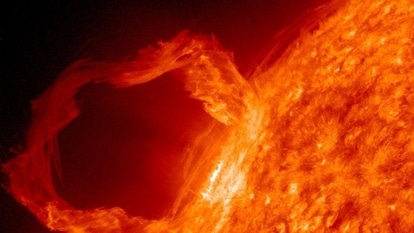As fast-moving solar winds engulf the Earth, Dangerous geomagnetic storm strikes
A geomagnetic storm struck the Earth in the late hours of July 12 after fast-moving solar winds surrounded the Earth. Know the damage it caused and what the future may hold with increasing solar activity.


Solar activity has been consistently increasing on the Sun and scientists are beginning to worry that a massive geomagnetic storm might just be around the corner. In the late hours of July 12, the Sun ejected fast-moving solar winds towards the Earth which resulted in a geomagnetic storm. This geomagnetic storm is the latest in a series of solar attacks on Earth by the Sun. Last week, a particularly dangerous sunspot called AR3053 blasted a couple of M-class solar flares towards our planet and it caused widespread radio blackouts and GPS disruptions. While this latest geomagnetic storm was not strong enough to cause blackouts, it did impact shortwave radio frequencies. Know details and the reason behind this increased solar activity.
SpaceWeather.com reported, “A brief G1-class geomagnetic storm erupted on July 12th when Earth entered a stream of fast-moving solar wind. Shock-like discontinuities in the solar wind data suggest that one or more minor CMEs might have been embedded in the stream. No auroras have been reported, probably because of full moonlight”. While luckily, this one was just a G1-class storm, more solar storms are expected this week, which might be much stronger than this one.
Geomagnetic storm raises concerns about further solar activity
Right now, the Sun is moving towards the solar maximum phase of its solar cycle. A solar cycle is an 11-year long period for a Sun during which it reaches two phases — solar maximum where the solar activity, including coronal mass ejections (CME), solar flares and geomagnetic storms are at an all time high, and solar minimum where the solar activity is minimized. The Sun will reach its solar maximum in 2023 and till then it is expected that more sunspots will appear on the Sun, which will give rise to more spontaneous solar combustions.
Some of these geomagnetic storms can be as severe as a G5-class storm, which can not only damage satellites but also GPS systems, mobile network, internet services and power grids. We have already experienced such a dangerous geomagnetic storm in 1859 when telegraph systems randomly caught fire and started displaying sparks. The event is widely known as the Carrington event.
Catch all the Latest Tech News, Mobile News, Laptop News, Gaming news, Wearables News , How To News, also keep up with us on Whatsapp channel,Twitter, Facebook, Google News, and Instagram. For our latest videos, subscribe to our YouTube channel.































